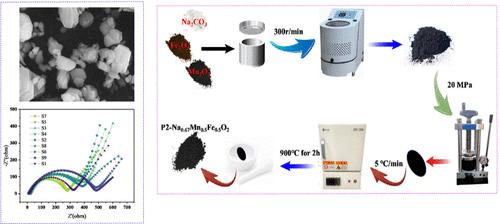Facile Design and Synthesis of Co-Free Layered P2-Na2/3Fe1/2Mn1/2O2 as Advanced Cathode Material for Sodium-Ion Batteries
IF 8.3
2区 材料科学
Q1 MATERIALS SCIENCE, MULTIDISCIPLINARY
引用次数: 0
Abstract
Co-free Fe/Mn-based cathodes have become a popular choice for sodium-ion batteries (SIBs) due to their affordability and impressive theoretical capacity. Nevertheless, the issue of their terrible battery life and rate capability continues to be their hindrances. A set of three-factor, three-level orthogonal experiments was adopted, including the calcination temperature, calcination time, and heating rate. And two single-factor experiments were carried out to further optimize the preparation conditions. Finally, the optimal conditions were obtained as follows: the calcination temperature was 900 °C, the calcination time was 12 h, and the heating rate was 5 °C min–1. The layered oxide cathode material Co-free P2-Na2/3Fe1/2Mn1/2O2 was synthesized by the solid phase method. Under the control of the optimal conditions, the P2-Na2/3Fe1/2Mn1/2O2 cathode could yield a remarkable initial discharge specific capacity (179.3 mAh g–1, 0.1 C) and cycle stability (54.6% over 50 cycles). These findings further declared that it was feasible to design Co-free Fe/Mn-based cathode materials with superior performance, which might offer guidance for popularizing cost-effective Fe/Mn-based cathode materials in the future.

作为钠离子电池先进阴极材料的无共价层状 P2-Na2/3Fe1/2Mn1/2O2 的简易设计与合成
无钴铁/锰基阴极因其经济实惠和惊人的理论容量而成为钠离子电池(SIB)的热门选择。然而,其电池寿命和速率能力的问题仍然是其发展的障碍。实验采用了一组三因素、三水平正交实验,包括煅烧温度、煅烧时间和加热速率。并进行了两次单因素实验,进一步优化制备条件。最后得到了最佳条件:煅烧温度为 900 ℃,煅烧时间为 12 h,加热速率为 5 ℃ min-1。通过固相法合成了不含 Co 的层状氧化物正极材料 P2-Na2/3Fe1/2Mn1/2O2。在最佳条件控制下,P2-Na2/3Fe1/2Mn1/2O2阴极可产生显著的初始放电比容量(179.3 mAh g-1,0.1 C)和循环稳定性(54.6%,50 次循环)。这些发现进一步表明,设计性能优越的无钴铁/锰基阴极材料是可行的,这可能为将来推广具有成本效益的铁/锰基阴极材料提供指导。
本文章由计算机程序翻译,如有差异,请以英文原文为准。
求助全文
约1分钟内获得全文
求助全文
来源期刊

ACS Applied Materials & Interfaces
工程技术-材料科学:综合
CiteScore
16.00
自引率
6.30%
发文量
4978
审稿时长
1.8 months
期刊介绍:
ACS Applied Materials & Interfaces is a leading interdisciplinary journal that brings together chemists, engineers, physicists, and biologists to explore the development and utilization of newly-discovered materials and interfacial processes for specific applications. Our journal has experienced remarkable growth since its establishment in 2009, both in terms of the number of articles published and the impact of the research showcased. We are proud to foster a truly global community, with the majority of published articles originating from outside the United States, reflecting the rapid growth of applied research worldwide.
 求助内容:
求助内容: 应助结果提醒方式:
应助结果提醒方式:


